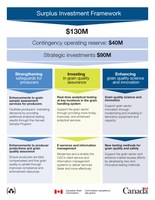WINNIPEG, Aug. 1, 2018 /CNW/ - Canadian producers will have access to even more information on the quality of their harvest thanks to enhancements to the Canadian Grain Commission's Harvest Sample Program.
Beginning in the 2018-19 crop year, producers who participate in the Harvest Sample Program will receive falling number and deoxynivalenol (DON) results for their wheat samples at no cost. With this additional information in hand, producers will be better able to market their crop to ensure the best return for their farms.
These enhancements to the Harvest Sample Program will be funded for the next 5 years through the investment of $4 million from the Canadian Grain Commission's accumulated surplus. This is the first step in the Canadian Grain Commission's plan to invest $90 million through a Surplus Investment Framework that will strengthen safeguards for producers, improve grain quality assurance programs and enhance grain quality science and innovation.
The Canadian Grain Commission is committed to working with grain sector stakeholders to ensure enhancements to programs and services deliver clear benefits to producers and add value to the sector into the future. In the coming months, the Commission will consult with grain sector stakeholders to develop more detailed proposals within the Surplus Investment Framework.
Quotes
"We are pleased to announce a key investment in the Harvest Sample Program. It's an important tool that makes data available to promote the sale of Canadian grain, helps producers ensure the best return for their crops, and contributes to research on grain grades and the end-use quality of Canadian grain."
"The Canadian Grain Commission will invest surplus funds in programs and activities will meet the evolving needs of the grain sector for years to come. We look forward to working with stakeholders to maximize the value of surplus investment initiatives."
Patti Miller,
Chief Commissioner, Canadian Grain Commission
Related products
- Backgrounder
- Infographic : Surplus Investment Framework
Quick facts
- The Harvest Sample Program is a voluntary program that offers free analytical services to Canadian grain producers and grain companies.
- The Canadian Grain Commission uses samples to generate annual crop quality data and to conduct research that support market access for Canadian grains.
Associated links
Canadian Grain Commission
The Canadian Grain Commission is the federal agency responsible for establishing and maintaining Canada's grain quality standards. Its programs result in shipments of grain that consistently meet contract specifications for quality, safety and quantity. The Canadian Grain Commission regulates the grain industry to protect producers' rights and ensure the integrity of grain transactions.
Surplus Investment Framework Backgrounder
Funding model
The Canadian Grain Commission (CGC) is financed through a revolving fund, with over 90% of its operations funded on a cost-recovery basis, through fees. These fees are primarily earned through official grain inspection and weighing services provided to grain exporters. Amounts collected from year to year fluctuate based on inspected grain volumes.
In years with higher-than-average grain volumes, the CGC will accumulate surpluses in its revolving fund, while in years with a lower-than-average volumes, it will draw on those surpluses.
Accumulation of surplus
As of December 31, 2017, the CGC had a revolving fund surplus of approximately $130 M. This surplus was accumulated because of higher than anticipated grain volumes and lower than expected spending.
To reduce the risk of surplus accumulation, the CGC lowered its official inspection and weighing fees before the end of its five-year funding cycle on August 1, 2017. These changes better aligned the fees collected by the CGC with the cost of service provision.
Potential uses of accumulated surplus
The CGC also presented a discussion document on possible uses for the accumulated surplus in 2017. Stakeholders provided feedback that the surplus should be directed towards activities that deliver clear benefits to producers and add value to the sector.
The options put forward in the discussion document were analyzed in further detail, as well as other proposals brought forward by sector stakeholders. In considering approaches for using the surplus, the CGC's primary objective was to ensure that it would deliver clear benefits to the sector as a whole, including producers.
The CGC looked carefully at the option of returning the money to the sector, and to producers specifically. The Canada Grain Act does not currently allow refunding fees collected from the grain companies to producers. In addition, returning the money directly to the companies that paid the fees may not result in direct benefits to producers. As a result, the CGC concluded that producers would see the greatest benefit if the surplus was used to strengthen and enhance programs offered to the sector.
Surplus Investment Framework
The Surplus Investment Framework will channel approximately $90M in surplus funds into initiatives across three key strategic areas, which touch all aspects of the grain sector:
- strengthening safeguards for producers,
- investing in grain quality assurance, and
- enhancing science and innovation in the grain sector.
In addition to amounts spent through the Surplus Investment Framework, $40 M will be set aside for a contingency operating fund, to cover downward fluctuations in grain volumes. This will ensure consistent service levels and stable fees for the years to come.
The CGC will consult further with the grain sector on individual initiatives under the Surplus Investment Framework going forward.
SOURCE Canadian Grain Commission

Rémi Gosselin, Head of Communications, Canadian Grain Commission, 204-983-2749, [email protected]


Share this article